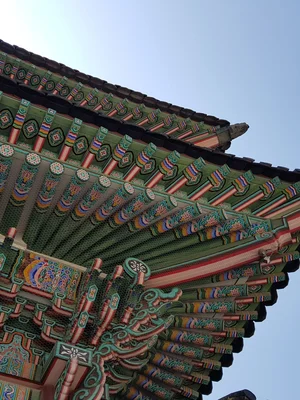Classical Korea: Autumn by Train
Starting at: $1,682.00
per personmore
group
Limited Spots Available
Spots Left: 17
groups
Maximum Group Size
20
fitness_center
Fitness Level
Moderate
schedule
Duration (Nights/Days)
6 night, 7 day
flight_land
Arrival ~ Departure
Sun, Oct 12, 25 ~ Sat, Oct 18, 25
timer
Time left until the start
eventTime's up!
luggage What's included
check_circle Included
check
entrance fee
check
transportation
check
transfers as in daily schedule
check
breakfasts, if selected accommodation with breakfasts (BB)
check
accommodation in accordance with your selection
check
excursions as in daily schedule
check
licensed guide
cancel Not Included
close
personal expenses and all other expenses not specified explicitly in the program
close
Tip for the guide and driver
star What Our Guests are Saying
explore Experience on This Tour
auto_awesome Magic Moments
Take a stroll through nighttime Gyeongju — among softly lit ancient tombs and the pavilions of the Eastern Palace, reflected in the mirror-like surface of the pond.
Feel a thrill as you ride a cable car over the sea in Busan, then catch the rhythm of dance and live music under the open sky in an autumn folk village.
Pause before petroglyphs carved into a valley surrounded by golden autumn cliffs.
Drop by both Starfield libraries and feel how, in Gangnam, history and the future quietly brush past one another.
Ride on KTX high-speed train
Travel long distances in comfort and style, saving time while enjoying a quintessential Korean experience.
Excursion to Ulsan’s Petroglyphs
A rare chance to encounter prehistoric art in its original setting—feel the continuity of human imagination through millennia.
Group transfers included
Our drivers with name signs will meet (and see off) any flight on your arrival day (or earlier!) and on the tour’s final day (or later!).
→ Arrive and depart when it’s convenient for you — transfers are included and everything’s arranged.
Sea cable car ride
A scenic, elevated adventure offering breathtaking views over Korea’s coast.
Unique places not yet overrun by tourists
Be among the first to explore a place still untouched by mass tourism — but not for long.
Starfield Library in Suwon
If you've heard about the famous Starfield Library in Gangnam — yes, you'll see it.
But the real surprise is waiting in Suwon.
Licensed Guide Only
Sure, you can follow influencers — but only licensed guides in Korea are allowed to legally accompany tourists. That means better access, fewer risks, and no awkward surprises during your trip
Experiences
Gyeongju
keyboard_arrow_down
Seoul
keyboard_arrow_down
Suwon
keyboard_arrow_down
Ulsan
keyboard_arrow_down
Yongin
keyboard_arrow_down
Base hotels (subject to change)
Sotetsu Hotels The Splaisir Seoul Myeongdong
Seoul
****
Commodore Hotel Gyeongju
Gyeongju
****
Toyoko Inn Busan Haeundae 2
Busan
**
Best Western Premier Gangnam
Seoul
****
Brief price table.
Pax per Room:
1
price
$2,184.00
final price
$2,184.00
Pax per Room:
2
price
$1,682.00
final price
$1,682.00
Frequently asked questions
Why trains instead of a tour bus?
expand_moreI’ve already been to Seoul. Will there be anything new for me?
expand_moreWhere should I exchange currency in South Korea?
expand_moreWhat’s the weather like in Korea in autumn?
expand_moreIs all Korean food spicy?
expand_moreHow much money should I exchange for daily expenses in South Korea?
expand_moreWhat to do with unused Korean currency?
expand_moreWhat currency should I take with me?
expand_more